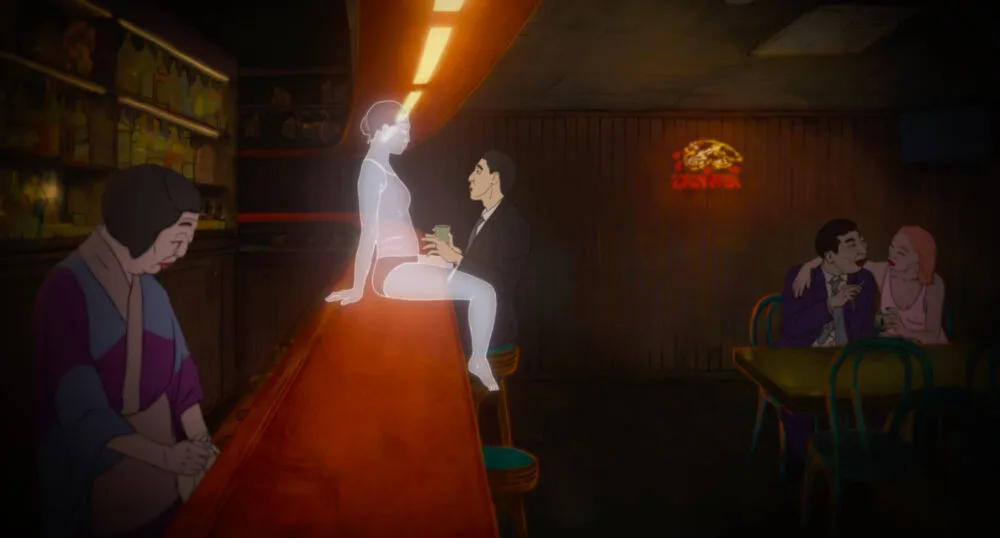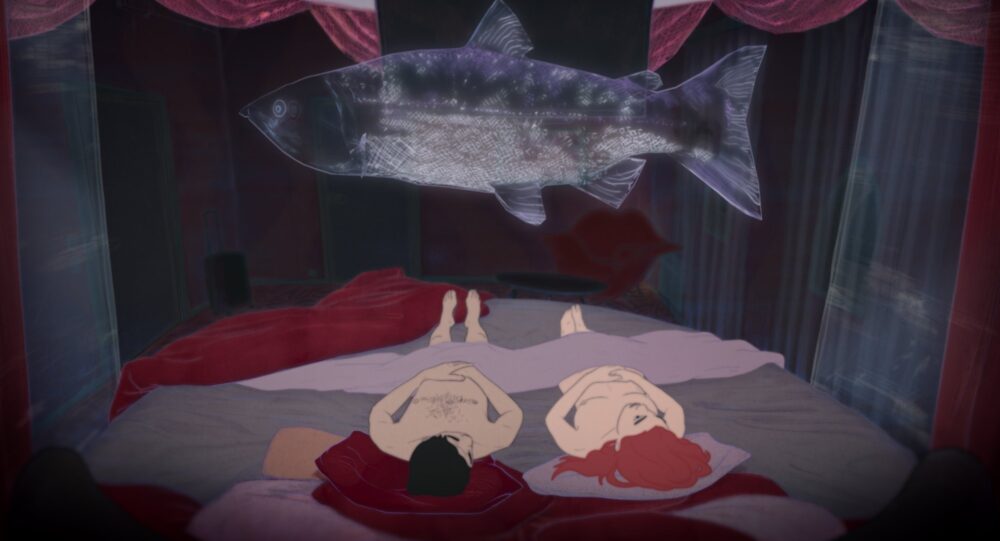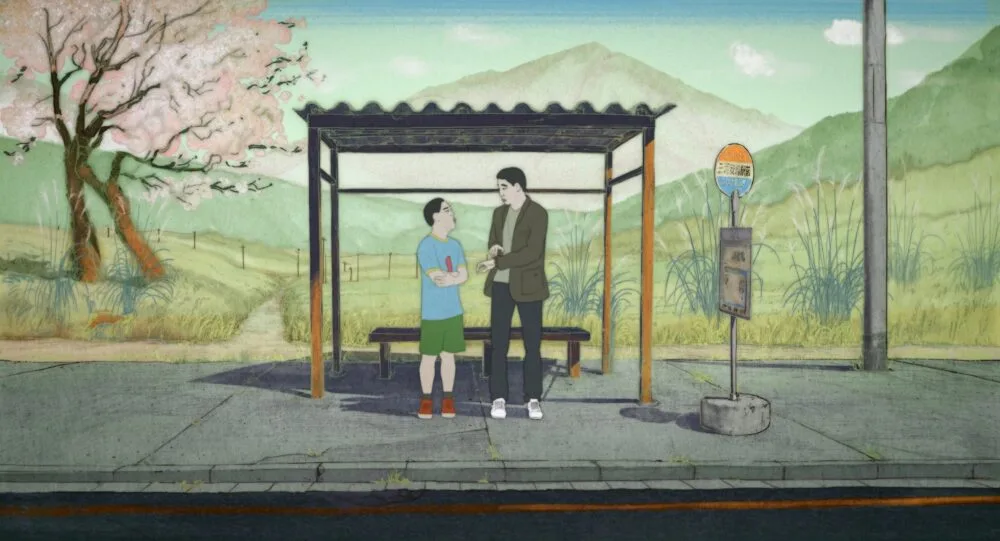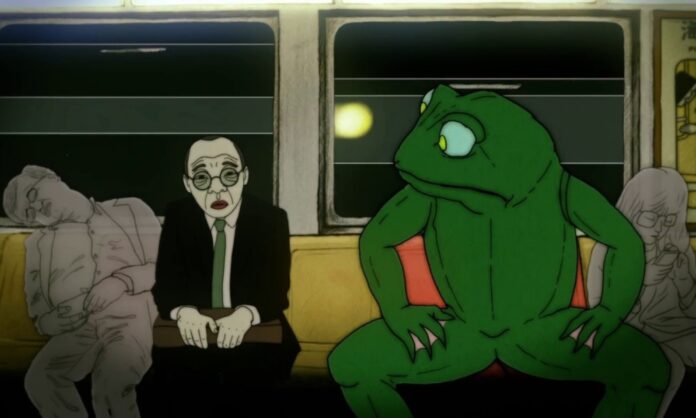“Among the many values in life, I appreciate freedom most.”
— Haruki Murakami
Freedom was a “most generous gift” given to artist and composer Pierre Földes when adapting the esteemed Japanese author’s work for his directorial debut Blind Willow, Sleeping Woman. The animated anthology is inspired by three collections — including Elephant Vanishes (1993) and After the Quake (2000) — sits alongside Richard Linklater’s rotoscoped films as work that blur the boundaries between animation and live-action.
Understanding Földes’ intimate and instinctive approach is as much down to his explanations on technique, as it is in appreciating his own sensitivities and expressions for the source material. Murakami’s writing provided him an open book of oddities; those “dreams that shape us and the things we wish for.”

Burning Inspiration
Exploring these stories inspired Földes to push himself and the original text even further while retaining the perfect balance of two distinct artists. Experimentation is a natural process for Földes, integral to not just developing the style of the film but as an auteur, his style… and the key here was a “live animation” technique that evolved during production.
The final animation retains both the nuances and dream-like effects we would expect from the marriage of Murakami and the moving image. His eccentric and eclectic nature often displayed through his redemptive characters, many of whom confront their heritage through love and loss, spirituality, sexuality, identity, prophecies, and fate. Of course, that meant there was a wealth of inspiring themes to choose from.
![Pierre Foldes [c/o Miyu]](https://www.animationmagazine.net/wordpress/wp-content/uploads/Pierre-Foldes_Miyu-1024x768-1-240x240.jpg)
“I tend to listen to my desires and was therefore attracted to very specific stories,” says Földes. ”I’d also add that, as an artist, what inspires and attracts me are things I can’t quite define. Things that can relate to something deeper than just mere social and storyline events that anyone else can do very well. Rather than picking one story, I felt the desire to pick a few and to lose myself in them as though in the middle of a maze; to go for what attracted me in them and, eventually, find my way out.”
At the beginning of the project, Földes intended to mix live-action with animation, “I love working with actors and in that sense, I’m more of a live-action director who loves creating a unique image and experience using everything I have to express exactly what I have in mind. Animation and music are just some of the tools I have at hand, but it was essential for me to shoot the whole film with actors prior to working on the animation as the film has such precise dialog. They gave so much life to my characters.”
Over two and a half years, Földes primarily utilized his skills as an artist rather than settling on animation from the offset. “Somehow, little by little, as the project evolved, it became a full animation film. The way I approach any project is thinking in layers, both horizontal and vertical, meaning that I have a kind of vision of something — a feeling — and then I very carefully build upon that raw vision to create various levels until I feel I have created what I imagined deep inside.”

Careful Consideration
Földes’ father was a painter and animator and, although having always been in that world as a trained composer, he saw this as his greatest asset. “As an artist, I can’t imagine just hiring animators and doing animation. But, when I started working on my own films, I experimented with animation, always creating and experimenting with my own techniques eventually coming up with what I called ‘live animation.’ The film has lots of subtle dialog expressed by subtle characters. After drawing the storyboard, I directed the actors and, having also created the character design, actually enjoyed playing the Frog character myself.”
The film, which won the Jury Distinction Prize at Annecy last year, was produced remotely, with Földes utilizing Toon Boom for the storyboards and animatics, an edit of the film then used as a guide for shooting the live-action in Montreal where he worked on After Effects, compositing and color correcting. The final animation was produced at various studios across France and Luxembourg polishing the colors and backgrounds. (Cinema Defacto, Miyu Productions, Doghouse Films, Studio MA and micro_scope are among the various producing entities.)

Working as the production designer helped with directing the 2D animation process: Földes sculpted 3D heads with ZBrush for each character so that once the live action was fully edited there were full references capturing the actors’ movements and expressions for the animators to work on. “Rather than simply rotoscoping, the animator had to understand and capture the details of emotion and intention of the actors to recreate something unique for each character. The process of hiring the animators was solely based on their drawing capabilities and their openness to putting aside most things they had learned concerning movements. I encouraged them to concentrate on details such as expressions and giving depth to their lines; to lend more life and ‘animate’ their characters.”
Then there’s the soundscape. It has been noted that music is Murakami’s first love and therefore, as an appreciator of jazz in particular, he is no stranger to improvisation. “Of course, I’ve always heard of Mr. Murakami’s deep interest in music,” says the director. “All kinds of music. My approach is one of an artist whose only credo is inspiration and audacity. I only listen to what I have inside, but then I listen very very carefully, and if I’m concentrated enough, I catch a few notes, a few colors, a few ideas here and there … and I follow them, and them only; until I create something that’s 100 percent true.”

A Realization
Having made it clear from the offset that he wasn’t to be involved, anyone else would have read Murakami’s response as “an unfriendly move.” However, Foldes says, “It allowed me to go from a ‘respectful’ approach to a much more personal one; to embrace his beautiful and amazing work and be so inspired by it that it gradually became mine. I think that, to a certain extent at least, once you’ve read the words written in a book, the concepts they inspire in your mind, are yours.”
Indeed, Földes lends new life and dimension to Murakami’s work, while taking complete ownership. He is obviously a meticulous director who articulates and interprets what he feels as an artist emotionally, while still delivering something malleable.

If a tsunami and an earthquake weren’t enough to induce any emotion (or anxieties!), the inherent psychological tones are certainly echoed enough through the use of texture, fragmented color, and line work. Földes style also perfectly translates the disparate characters — a schizophrenic accountant, and a giant (talking) anthropomorphic frog — unbound from reality. “These concepts can trigger much deeper ones,” says the director. “They can inspire your own personal world which, in turn, can create something unique that might open windows in people’s minds or hearts and, in turn, inspire them. That’s what I’m going for.”
Blind Willow, Sleeping Woman premieres at the Film Forum in New York City on April 14, screening in select U.S. theaters through Zeitgeist Films in association with Kino Lorber.













